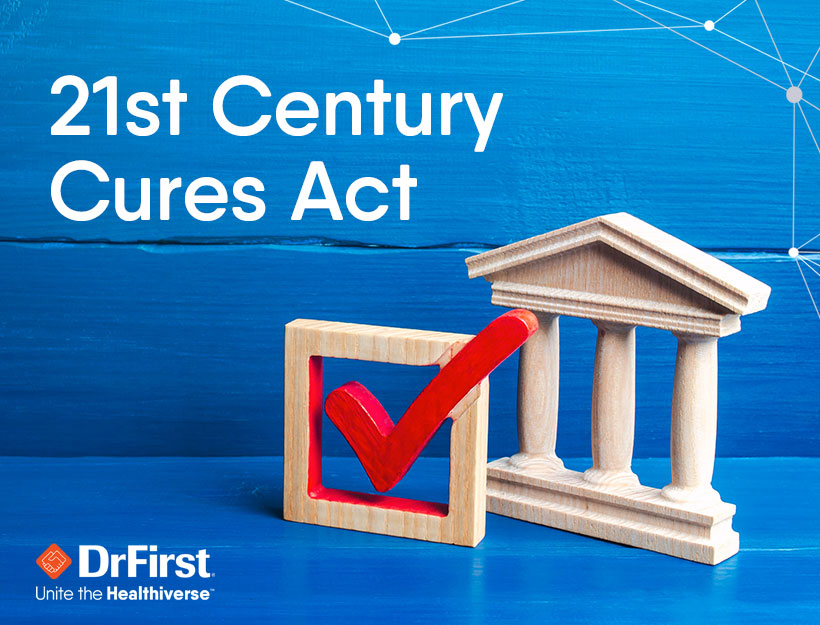Nick Barger, PharmD
21st Century Cures Act: Opportunities and Risks for EHR and HIT Vendors
It’s finally here. After years of planning, analysis, and debate, the 21st Century Cures Act ONC Final Rule is in place. What does this mean for health IT developers? Plenty!
You are now required to make sure your platforms can provide patients with timely access to their electronic health information—such as test results, medication lists, and clinical notes. Failure to do so could bring fines up to $1 million per violation of the law’s Information Blocking Final Rule.
These rules are intended to advance interoperability. Health IT developers must enable the exchange of data using the United States Core Data for Interoperability (USCDI) standard and an application programming interface (API) in the HL7 Fast Healthcare Interoperability Resources (FHIR) format. These acronym-rich requirements will fundamentally ease how patients access their health information and facilitate how records are shared among providers and health systems.
Adding Value for Customers While Meeting Regulatory Requirements
Complying with an ever-changing regulatory environment isn’t easy. But as with everything in life, there are risks and opportunities. Here are some ways to position your company and your customers to dodge the risks while getting the biggest benefit from the opportunities.
Risk: Outdated business models.
When patient records were kept in a paper chart, requests for medical information required a staff member to make physical copies to mail or fax to the patient. Today, with nearly universal adoption of EHRs, it should be easy to share records electronically, right? Unfortunately, it’s not that simple. When different systems aren’t compatible, the exchange of data still depends on some manual processes, such as typing in information that tends to get lumped together as “free-text” instead of being imported into distinct fields in the EHR. This lack of interoperability puts you—and your customers—at risk of non-compliance. It also could jeopardize your relationship with your clients.
Opportunity: New partnerships and revenue generation.
Now is the time to update your business models to offer systems that not only store data but also allow it to be shared easily. You have three choices on how to approach it: Build interoperable solutions on your own, acquire a company that already has those solutions, or engage a trusted development partner. Partnerships bring significant benefits by relieving you from the burden of developing new products, so your team can focus on acquiring new customers and supporting existing ones. Innovative partner solutions that integrate seamlessly with existing workflows can meet both your customers’ needs and regulatory requirements, presenting new revenue opportunities for you.
Risk: Product development burdens.
Think about your development roadmap. Offering minimally viable products that simply check the box from a regulatory perspective will not position your company for growth. If you don’t have the bandwidth to build strong products with powerful features, you could place unrealistic demands on your network, your developers, and even your organization’s infrastructure—and damage your reputation, as well.
Opportunity: Differentiating your company from the competition.
Many EHRs have become homogenized to some extent because every vendor needs to include certain features and functions to meet Meaningful Use and Merit-Based Incentive Payment System (MIPS) requirements. So, how can you differentiate your solutions with features that go above and beyond what your competition is offering? The standardization of APIs presents an opportunity to add solutions that help providers work more efficiently without navigating separate workflows or disconnected systems. With in-workflow solutions that make real-time patient data available at the point of care, you can support clinical decision-making, help avoid medication errors, and provide price transparency tools.
Risk: Increased competition for customers.
The digital transformation of healthcare is forcing change faster than ever. In this fiercely competitive market, your solutions must accommodate provider needs, comply with numerous mandates, and continue to innovate to keep up with evolving demands.
Opportunity: Building customer loyalty.
Healthcare providers want to meet regulatory requirements without a lot of burden. They also want technology solutions that streamline their clinical workflows rather than complicating them. You can earn customer loyalty in ways that can be a game-changer for your business by helping your clients do both with seamless, in-workflow solutions.
Don’t Be an Information-Blocker
See how DrFirst’s integrated solutions can help you innovate faster, generate new revenue streams, and gain back product and technical resources for your strategic initiatives.


















